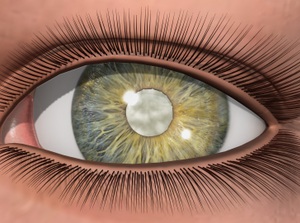Cataracts
A cataract is a clouding of the normally clear lens of the eye. The lens is what focuses light from the outside world onto your retina. If the lens is cloudy, hazy, yellow or opacified, the image formed on the retina is not sharp or clear and the result is blurred vision.

View Video: After Cataract (Secondary Cataract; Posterior Capsular Opacification; PCO)

View Video: Cataracts
Cataract formation
Cataracts usually develop as part of the normal aging process of the eye, the center of the lens becomes thicker and yellow as a person ages. However, cataracts can form at an earlier age from certain medical problems (such as diabetes), injuries to the eye, medications (such as steroids), previous eye surgery, long-term, unprotected exposure to sunlight and other unknown genetic factors. A cataract can develop in any part of the lens. It can make the lens thicker, irregularly shaped, denser, yellow or brown, or even shift the lens to a slightly different position within the eye. Cataracts may also develop rapidly, seemingly over a few weeks to months, or slowly progress over years with only minimal visual changes. But whatever the type or severity, cataracts all have one thing in common: a decrease in clear vision.
Symptoms
As there are many different types of cataracts that exist, there are equally as many different symptoms. Common symptoms include: glare or light sensitivity, needing brighter light to read, difficulty with night driving, double vision in one eye, fading or dimming of colors and/or frequent change in eyeglass prescription.
Detection
Although the symptoms of cataracts may be common, the only way to determine if a cataract is present is through a complete examination by an eye care professional. There are many possible reasons for blurred or decreased vision. It is important to determine the cause and extent of vision loss before deciding on appropriate treatment.
Treatment
The only real treatment for a cataract is surgical removal. Contrary to popular belief, cataracts are not removed by laser. Most cataract surgery today is done by ultrasound disruption of the lens, called phacoemulsification, with placement of a clear acrylic or silicone lens implant. Once a cataract is removed, it cannot “grow back.” But, in about 10 percent of people, a thin membrane can form on the back of the implant. This can be removed simply and in just a few minutes with a laser.
Cataract surgery is the most common and most successful surgery in America. Roughly 1.4 million cataract surgeries are performed each year, with a greater than 95 percent success rate. However, as with any surgery, there are risks, and these should be discussed in detail with the ophthalmologist before planning cataract surgery.

